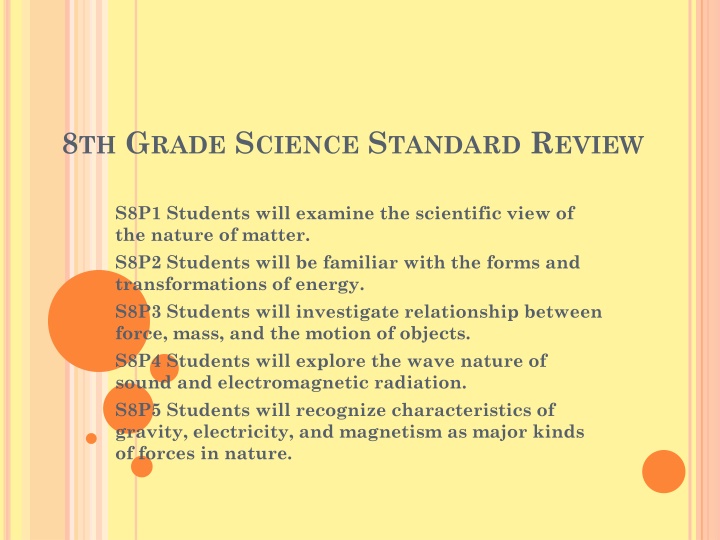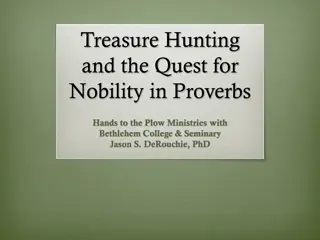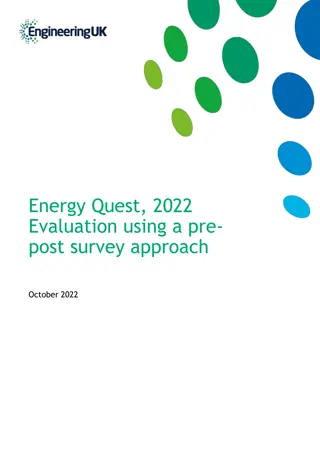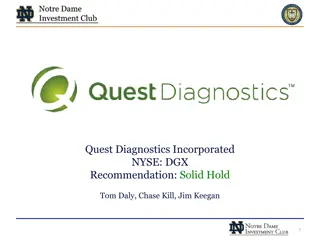
8th Grade Science Standard Review: Atoms, Molecules, Mixtures, Sound, Research Ethics
Explore key concepts in 8th-grade science such as the nature of matter, energy forms, force, wave nature of sound, gravity, electricity, and magnetism. Test your knowledge on atoms vs molecules, mixtures, sound processes, animal research ethics, and unit conversion.
Download Presentation

Please find below an Image/Link to download the presentation.
The content on the website is provided AS IS for your information and personal use only. It may not be sold, licensed, or shared on other websites without obtaining consent from the author. If you encounter any issues during the download, it is possible that the publisher has removed the file from their server.
You are allowed to download the files provided on this website for personal or commercial use, subject to the condition that they are used lawfully. All files are the property of their respective owners.
The content on the website is provided AS IS for your information and personal use only. It may not be sold, licensed, or shared on other websites without obtaining consent from the author.
E N D
Presentation Transcript
8TH GRADE SCIENCE STANDARD REVIEW S8P1 Students will examine the scientific view of the nature of matter. S8P2 Students will be familiar with the forms and transformations of energy. S8P3 Students will investigate relationship between force, mass, and the motion of objects. S8P4 Students will explore the wave nature of sound and electromagnetic radiation. S8P5 Students will recognize characteristics of gravity, electricity, and magnetism as major kinds of forces in nature.
1. HOW ARE ATOMS AND MOLECULES DIFFERENT? A. Atoms are comprised of more than one element and molecules are comprised of only one element. B. Atoms are comprised of only one element and molecules are comprised of more than one element. C. Both atoms and molecules are comprised of only one element. D. Both atoms and molecules are comprised of more than one element.
2. USE THE ABOVE PICTURE TO FILL IN THE BLANKS FOR THE FOLLOWING STATEMENT. TWO THE ELEMENT CHLORINE TO FORM THE OF THE ELEMENT SODIUM COMBINE WITH ONE OF SODIUM CHLORIDE. o A. atoms; atom; compound o B. atoms; molecule; compound o C. molecules; molecule; compound o D. compounds; atom; molecule
3. WHATDEFINESAMIXTURE? A. created through a chemical reaction B. described by a chemical formula C. cannot be broken down into simpler substances D. can be broken down into its basic substances through physical means
4. THEPROCESSTHATENABLESYOUTOHEAR THESOUNDOFADRUMAROUNDTHECORNER IS A. diffraction. B. polarization. C. refraction. D. absorption.
5. WHICHOFTHEFOLLOWINGSTATEMENTS ABOUTANIMALSUSEDINRESEARCHISTRUE? A. There are no laws that govern how animals in research facilities must be treated. B. More animals are used in research today than 20 twenty years ago. C. Animals are unnecessary in scientific research because alternatives are available. D. Federal laws specify that animals used in research must receive humane care and treatment.
6. STEPHENMEASUREDTHELENGTHOFA SECTIONOFARIVERAS 182 M. CONVERTTHIS MEASUREMENTTOCENTIMETERS. A. 182 cm B. 1,820 cm C. 18,200 cm D. 182, 000 cm
7. INWHICHOFTHEFOLLOWINGPHASESOF MATTERDOMOLECULESHAVETHELOWEST AMOUNTOFENERGY? A. solid B. liquid C. gel D. gas
8. CALCULATETHEDENSITYOFANOBJECT THATHASAMASSOF 10GANDAVOLUMEOF 5CM . REMEMBER: DENSITY=M/V A. 5 g/cm B. 5 g C. 2 g D. 2 g/cm
9. WHATISTHEARROWPOINTINGAT? A. Atomic Number B. Atomic Mass C. Number of electrons D. Element symbol
11. WHATISNOTONEOFTHE 3 ELEMENTAL FAMILIESONTHEPERIODICTABLE? A. metal B. metalloid C. nonmetal D. liquid
12. A SCIENTISTGATHEREDDATAINVOLVING THENUMBEROFTIMESDIFFERENTBIRDS LOCATEDFOODINAMAZE. INWHICHSETOF NUMBERSARETHEMEAN, MEDIAN, ANDMODE ALLEQUAL? A. {2,4,6,6,8,10} B. {2,6,6,8,10}. C. {2,2, 4,8,10,10}. D. {2,4,6,8,10}.
13. WHICHOFTHEFOLLOWINGMUSTBE TRUEIFANOBJECTISACCELERATING? A. Friction is not acting on the object. B. The object no longer has inertia. C. An unbalanced force is acting on the object. D. Balanced forces are acting on the object.
14. INACHEMICALREACTION, THETOTALMASS OFTHEREACTANTSIS 10.0 GRAMS. THETOTAL MASSOFTHEPRODUCTSMUSTBE: A. more than 10.0 grams. B. exactly 20.0 grams. C. exactly 10.0 grams. D. less than 10.0 grams.
15. WHICHCHARACTERISTICSOFLIGHT WAVESDETERMINESITSCOLOR? A. Amplitude B. Wavelength C. Speed D. Medium
16. SEVERAL DISK MAGNETS ARE PLACED NEAR A WIRE. WHENACURRENT ISALLOWEDTOFLOW, THEMAGNETSEXERTSA FORCEONTHEWIRE. WHYISTHISTRUE? A. magnetism flows from the magnets to the wire. B. Charges leak from the wire to the magnets. C. The poles of the magnets are reversed by the wire. D. The current is the wire produces a magnetic field.
17. PRECISIONCANBEDESCRIBEDAS REPEATABLEWHEREASACCURACYCANBE DESCRIBEDAS _________. A. Correct. B. Wrong. C. Approximate. D. Expected.
18. WATERISBOILEDANDSTEAMIS PRODUCED. THISISAPHYSICALCHANGE BECAUSETHEWATERPARTICLES A. are still water particles. B. have turned into something new. C. have been destroyed. D. have reacted with each other
19. HYDROELECTRICPOWERPLANTSUSETHE ENERGYINMOVINGWATERTOTURNTHE BLADESOFATURBINE. WINDPOWERPLANTS USETHEENERGYINWINDTOTURNTHE BLADESOFATURBINE. INBOTHCASES, THE FORMOFENERGYINVOLVEDINTHEMOVEMENT OFTHETURBINEBLADESIS A. electric energy B. thermal energy C. magnetism D. mechanical energy
20. CALCULATETHEMOMENTUMOFA 14 KG BICYCLETRAVELINGNORTHAT 2 M/S. REMEMBER: P=MV A. 28 kg m/s North B. 28 kg m/s C. 7 kg m/s North D. 7 kg m/s
21. IFYOUCOULDACCOUNTFORALLTHE ENERGYINPUTATTHEBEGINNINGOFA CHEMICALPROCESSINACLOSEDSYSTEM, A. You would be expect a lot of energy to be gone at the end. B. It would equal the amount of energy present in all forms at the end of the process. C. It would not change form or amount throughout the process. D. It would double by the end of the process.
22. WATERCANBEDESCRIBEDINAVARIETYOF WAYS. WHICHOFTHEFOLLOWINGSTATEMENTS DESCRIBESACHEMICALPROPERTYOFWATER? A. Ice melts into liquid water at a temperature of 0 degrees Celsius. B. At room temperature, water has an approximate density of 1 g/mL. C. Water is a generally unreactive compound. D. Liquid water vaporizes into steam at a temperature of 100 degrees Celsius.
23. THELAWOF _______ OFENERGYSTATES THATENERGYCANNOTBECREATEDOR DESTROYED. A. transformation B. conservation C. absorption D. stability
24. PERCENTOFTHEENERGYATEACHTROPHIC LEVELREACHESTHENEXTLEVEL. WHAT HAPPENSTOTHERESTOFTHEENERGY? INANECOSYSTEM, ONLYABOUT 10 A. It is used up and later replaced in nature. B. It is destroyed because it is not needed. C. It is converted to some other form, such as heat. D. It is changed into some type of matter such as soil.
25. A STONEHELDABOVETHEGROUNDHAS POTENTIALENERGY. WHENTHESTONEISDROPPED, POTENTIALENERGYISCONVERTEDTO _________ ENERGY. A. chemical B. electrical C. kinetic D. thermal
26. BETWEEN 2 OBJECTSCHANGEWHENTHE DISTANCEBETWEENTHEOBJECTSISDOUBLED? HOWDOESTHEGRAVITATIONALPULL A. The force is multiplied by 2 B. The force is multiplied by 4 C. The force is divided by 2 D. The force is divided by 4
27. SCIENTISTSHAVEDESIGNEDSOLARCELLS TOTRAPSOLARENERGYANDCONVERTITTO _____ ENERGY. A. hydroelectric B. wind C. chemical D. electrical
28. THEENERGYDIRECTLYASSOCIATEDWITH THEMOTIONOFCHARGEDPARTICLESIS A. Electrical energy B. Heat energy C. Mechanical energy D. Light energy
29. CALCULATETHEVOLUMEOFACUBE. 3 cm 2 cm 3 cm A. 8 cm B. 6 cm C. 9 cm D. 18 cm
30. WHICHOFTHEFOLLOWING CANNOT OVERCOMEANOBJECT SINERTIA? A. An unbalanced forced B. A zero net force C. Gravity D. Friction
31. TRANSLUCENTMATERIAL. HOWDOESTHE OBJECTAPPEARTOTHEPERSONONTHEOTHER SIDE ANOBJECTISPLACEDONTHESIDEOFA A. The object is seen clearly. B. The person sees the object, but it appears fuzzy. C. The person sees the object, but only in black and white. D. The person does not see the object at all
32. WHICHOFTHEFOLLOWINGISANEXAMPLE OFHEATTRANSFERTHROUGHCONDUCTION? A. hot air rising inside a house B. a pan on the stove getting hot C. the Sun drying clothes hanging outside D. a microwave warming a cup of water
33. LIGHTCANBESEPARATEDINTOTHE COLORSOFTHEVISIBLESPECTRUMWHEN A. The light is reflected off a smooth surface. B. The light is diffracted off a rough surface. C. The light is refracted by a prism. D. The light is refracted by a mirror.
34. WHENHOTANDCOLDAIRMEET, THEHOT AIRRISESTOTHETOP. WHICHPROCESS CAUSESTHEHOTAIRTORISE? A. induction B. convection C. radiation D. conduction
35. ANDAMIRRORTOFOCUSTHELIGHTFROM OBJECTSTHATAREFARAWAY? WHICHOFTHESEDEVICESUSESLENSES A. Microscope B. Prism C. Camera D. Telescope
36. WHENKINETICENERGYCHANGESTO POTENTIALENERGY, A. The total amount of energy stays the same B. The total amount of energy increases. C. The total amount of energy decreases. D. The total amount of matter decreases.
37.WHICHOFTHEFOLLOWING STATEMENTSABOUTRADIATIONISTRUE? A. Radiation is the only form of heat transfer that is not experienced on Earth. B. Radiation is the only form of heat transfer that is unable to travel through the vacuum of space. C. Radiation is the only form of heat transfer that is experienced on Earth. D. Radiation is the only form of heat transfer that can travel through the vacuum of space.
38. WHICHOFTHEFOLLOWINGISANEXAMPLE OFACCELERATION? I. A CARSPEEDSUP. II. A CARSLOWSDOWN. III. A CARTRAVELSINASTRAIGHTLINEAT ACONSTANTSPEED. IV. A CARTRAVELSATACONSTANTSPEED ANDTURNSLEFT. A. I and IV only B. III only C. I, II, and IV only D. I, II, III, and IV
39. INWHICHMOLECULEAREALLTHE ATOMSTHESAME? A. CO2 B. CCl4 C. CO D. Cl2
40. CALCULATETHESPEEDOFARUNNERTHAT TRAVELS 75 MIN 3 S. REMEMBER: SPEED = D/T A. 78 m/s B. 225 m/s C. 50 m/s D. 25 m/s
41. MASSANDDISTANCEBETWEEN 2 OBJECTSAFFECT A. Friction between the objects. B. Magnetic attraction between the objects. C. Gravitational attraction between the objects. D. Electrical attraction between the objects
42. WHICHOFTHEFOLLOWING DETERMINEANOBJECT'SVELOCITY? A. speed and mass B. speed and direction C. speed, direction, and acceleration D. direction and acceleration
43. APARALLELCIRCUIT. ONEOFTHEBULBSIS REMOVED. THERESTOFTHELIGHTSWILL A GROUPOFLIGHTSARECONNECTEDIN A. Start blinking B. Get dimmer C. Go out D. Stay lit
44. JENNIFERSTANDSONONESIDEOFA FILINGCABINETANDPUSHESWITHA FORCEOF 60 N. IF NATHANWANTSTO HELP JENNIFERDEMONSTRATEBALANCED FORCES, WHATDOESHENEEDTODO? A. cause the cabinet to move B. stand on the opposite side of the cabinet and push with a force of 60 N toward Jennifer C. stand on the opposite side of the cabinet and push with a force of 120 N toward Jennifer D. stand on the same side of the cabinet and push with a force of 60 N in the same direction as Jennifer
45. THETRANSFEROFHEATBY COLLISIONBETWEENATATOMSIS A. Conduction. B. Convection C. Radiation. D. Thermal energy
46. NEWTON'SFIRSTLAWSTATESTHATANOBJECTIN MOTIONWILLSTAYINMOTIONUNLESSACTEDUPON BYANUNBALANCEDFORCE. IFYOUROLLABALLACROSSTHEFLOOR, YOUPUT THEBALLINMOTION, BUTAFTERTIME, THEBALL STOPS. DOESTHISVIOLATE NEWTON'SFIRSTLAW? A. No, because the ball is acted upon by the unbalanced force of friction. B. Yes, because the unbalanced force of friction should have kept the ball moving. C. Yes, because the ball should have continued rolling forever. D. No, because Newton's laws are really only theories.
47. WHATHAPPENSTOASOUNDWHEN ITTRAVELSFROMAIRTOWATER? A. Its loudness increases. B. Its loudness decreases. C. Its speed increases. D. Its speed decreases.
48. LAST-MINUTE LOUISFRANTICALLYTRIEDTO FINISHHISHOMEWORKWHILEHISMOMDROVEHIM TOSCHOOL. HEPLACEDHISBOOKONHISLAPAND WASREACHINGFORAPENCILWHENHISMOM SUDDENLYSLAMMEDONTHEBRAKES. ALTHOUGH LOUISSTAYEDBUCKLEDINHISSEAT, HISBOOKFLEW FORWARDANDCRASHEDINTOTHEFRONT WINDSHIELD. WHICHOFTHEFOLLOWINGWASMOST RESPONSIBLEFORTHEBOOKFLYINGFORWARD? A. inertia B. gravity C. friction D. displacement
49. ELEMENTSINTHESAMECOLUMNOFTHE PERIODICTABLEISTRUE? WHICHOFTHESESTATEMENTSABOUT A. Elements in the same column have the same number of energy levels. B. Elements in the same column have similar properties. C. Elements in the same column have the same number of electrons. D. Elements in the same column are equally reactive
50. CALCULATETHEACCELERATIONOFABOX WHENTHENETFORCEONTHEBOXIS 1.0 N ANDTHEMASSOFTHEBOXIS 4.0 KG. REMEMBER: A = FNET/M A. 4.0 m/s B. 4.0 m/s C. 0.25 m/s D. 0.25 m/s





















